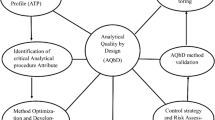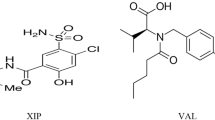Abstract
This paper proposes an innovative concept for robustness evaluation guided by two crucial aims: indubitable identification of the factors that significantly affect the LC method and avoidance of unnecessary time and money wasting. The first phase of the proposed strategy includes robustness screening during the method optimization. Initial assumptions of the method robustness can be tracked as the rate of the response change while the factors deviate within the expected range. Therefore, partial and total robustness criteria are calculated. If the results obtained are not satisfactory, re-optimization of the method should be considered. Otherwise, extensive robustness testing defined by experimental design and multi-level factors estimation should be performed to confirm the method robustness. Firstly, the important factors are investigated by the standard graphical (normal probability plots) and statistical (algorithm of Dong and error estimation based on a priori declared negligible effects) procedures. Since these approaches have several drawbacks, they can result in the appearance of false negative or false positive results. Thus, the modification of the statistical tests is advised in order to make the final conclusions. Special attention was dedicated to the advantages of the adapted algorithm of Dong (so-called 75 % approach) in the absence of the effect sparsity. The new approach is presented on the optimization and robustness testing of LC method for determination of ramipril and its five impurities. It is proved that the proposed strategy can perform an overall robustness estimation and successfully reveal all important factors.




Similar content being viewed by others
References
ICH Harmonised Tripartite Guideline, International Conference on Harmonisation of Technical Requirements for the Registration of Pharmaceuticals for Human Use (ICH) (2005) Validation of analytical procedures: text and methodology Q2(R1). http://www.ich.org/LOB/media/MEDIA417.pdf
Morgan E (1991) Chemometrics: experimental design, analytical chemistry by open learning. Wiley, Chichester
Vander Heyden Y, Massart DL (1996) Review of the use of robustness and ruggedness in analytical chemistry. In: Hendriks MWB, De Boer JH, Smilde AK (eds) Robustness of analytical chemical methods and pharmaceutical technological products. Elsevier, Amsterdam
Vander Heyden Y, Nijhuis A, Smeyers-Verbeke J, Vandeginste BGM, Massart DL (2001) Guidance for robustness/ruggedness tests in method validation. J Pharm Biomed 24:723–753
Malenović A, Jančić-Stojanović B, Vemić A, Ivanović D, Medenica M (2010) Validation of a column liquid chromatographic method for the analysis of pramipexole and its five impurities. J AOAC Int 93:1102–1112
Dejaegher B, Durand A, Vander Heyden Y (2009) Identification of significant effects from an experimental screening design in the absence of effect sparsity. J Chromatogr B 877:2252–2261
Rakić T, Malenović A, Jančić-Stojanović B, Ivanović D, Medenica M (2012) Avoiding the false negative results in LC method robustness testing by modifications of the algorithm of Dong and dymmy factor effects approach. Chromatographia 75:397–401
Vanbel PF, Tilquin BL, Schoenmakers PJ (1995) Criteria for developing rugged high-performance liquid chromatographic methods. J Chromatogr A 697:3–16
De Aguiar PF, Vander Heyden Y, Massart DL (1997) Study of different criteria for the selection of a rugged optimum in high performance liquid chromatography optimization. Anal Chim Acta 348:223–235
Gandhimathi M (2004) HPLC determination of losartan potassium and ramipril in tablets. Indian Drugs 41:120–122
Baing MM, Vaidya VV, Sane RT, Menon SN, Dalv K (2006) Simultaneous RP-LC determination of losartan potassium, ramipril, and hydrochlorothiazide in pharmaceutical preparations. Chromatographia 64:293–296
Rao P, Kumari V, Prakash B, Prabhakar G, Begum J (2006) Determination of ramipril in pharmaceutical dosage forms by reversed-phase liquid chromatography. Asian J Chem 18:788–792
Zarapakar SS, Rane SH (2000) Reversed-phase high-performance liquid chromatographic determination of ramipril and hydrochlorothiazide in tablets. Indian Drugs 37:589–593
Dhorda UJ, Shetkar NB (1999) Reverse phase HPLC determination of ramipril and amlodipine in tablets. Indian Drugs 36:638–641
Patole SM, Potale LV, Khodke AS, Damle MC (2010) A validated HPLC method for analysis of Atorvastatin calcium, Ramipril and Aspirin as the bulk drug and in combined capsule dosage forms. Int J Pharm Sci Rew Research 4:40–45
Pachauri S, Paliwal S, Srinivas KS, Singh Y, Jain V (2010) Development and validation of HPLC method for analysis of some antihypertensive agents in their pharmaceutical dosage forms. Int J Pharm Sci Rew Research 2:459–464
Rao KS, Srinivas K (2010) RP-HPLC method for the determination of losartan potassium and ramipril in combined dosage form. Indian J Pharm Sci 72:108–111
Kurade VP, Pai MG, Gude R (2009) RP-HPLC estimation of ramipril and telmisartan in tablets. Indian J Pharm Sci 71:148–151
Pili NR, Imadugu JK, Mullangi R, Karra VK, Vaidya JR, Rao JVLNS (2011) Simultaneous determination of atorvastatin, amlodipine, ramipril and benazepril in human plasma by LC-MS/MS and its application to a human pharmacokinetic study. Biomed Chromatogr 25:439–449
Gupta UK, Jain R, Lukram O, Asarwal S, Dwivedi A (2011) Simultaneous determination of ramipril, ramiprilat and telmisartan in human plasma using liquid chromatography tandem mass spectrometry. Talanta 83:709–716
Tan A, Jin W, Deng F, Hussain S, Musuku A, Masse R (2009) Bioanalytical method development and validation using incurred samples-Simultaneous quantitation of ramipril and ramiprilat in human EDTA plasma by LC-MS/MS. J Chromatogr B 877:3673–3680
Parekh SA, Pudage A, Joshi SS, Vaidya VV (2009) Simultaneous determination of simvastatin, simvastatin acid, ramipril and ramiprilate in human plasma by liquid chromatography-tandem mass spectrometry. Asian J Chem 21:3467–3479
Panchal HJ, Suhagia BN, Patel NJ, Rathod IS, Patel BH (2009) Simultaneous estimation of atorvastatin calcium, ramipril and aspirin in capsule dosage form by RP-LC. Chromatographia 69:91–95
Yuan B, Wang X, Zhang F, Jia J, Tang F (2008) Simultaneous determination of ramipril and its active metabolite ramiprilat in human plasma by LC-MS-MS. Chromatographia 68:533–539
Gowda KV, Mandal U, Selvan PS, Solomon WDS, Ghosh A, Sarkar AK, Agarwal S, Rao TN, Pal TK (2007) Liquid chromatography tandem mass spectrometry method for simultaneous determination of metoprolol tartrate and ramipril in human plasma. J Chromatogr B 858:13–21
Lakshmi KS, Sivasubramanian L, Pal K (2010) Stability indication HPTLC method for simultaneous determination of telmisartan and ramipril in tablets. Int J Pharm Pharm Sci 2:127–129
Elshanawane AA, Mostafa SM, Elgawish MS (2008) Application of a validated, stability-indicating LC method to stress degradation studies of ramipril and moexipril.HCl. Chromatographia 67:567–573
Seshadri RK, Desai MM, Raghavaraju TV, Krishnan D, Rao DV, Chakravarthy IE (2010) Simultaneous quantitative determination of metoprolol, atorvastatin and ramipril in capsules by a validated stability-indicating RP-UPLC method. Sci Pharm 78:821–834
(2011) European Pharmacopoeia, (2011) European Directorate for the Quality of Medicines and HealthCare (EDQM & HealthCare), Council of Europe
Jančić-Stojanović B, Popović I, Malenović A, Ivanović D, Medenica M (2010) Factorial design in optimization of chromatographic separation of ramipril and its impurities. Chromatographia 71:799–804
Orlandini S, Gotti R, Giannini I, Pasquini B, Furlanetto S (2011) Development of a capillary electrophoresis method for the assay of ramipril and its impurities: an issue of cis–trans isomerization. J Chromatogr A 1218:2611–2617
Goupy J (2005) What kind of experimental design for finding and checking robustness of analytical methods? Anal Chim Acta 544:184–190
Acknowledgments
The authors thank the Ministry of Education and Science of the Republic of Serbia for supporting these investigations through the Project 172052.
Author information
Authors and Affiliations
Corresponding author
Additional information
Published in the topical collection Chemometrics in Chromatography with guest editors B. Jančić-Stojanović and Y. Dotsikas.
Rights and permissions
About this article
Cite this article
Rakić, T., Vemić, S., Jančić-Stojanović, B. et al. Multi-Level Robustness Evaluation Approach: From Robustness Criterion to Adapted Algorithm of Dong. Chromatographia 76, 267–277 (2013). https://doi.org/10.1007/s10337-012-2317-2
Received:
Revised:
Accepted:
Published:
Issue Date:
DOI: https://doi.org/10.1007/s10337-012-2317-2




